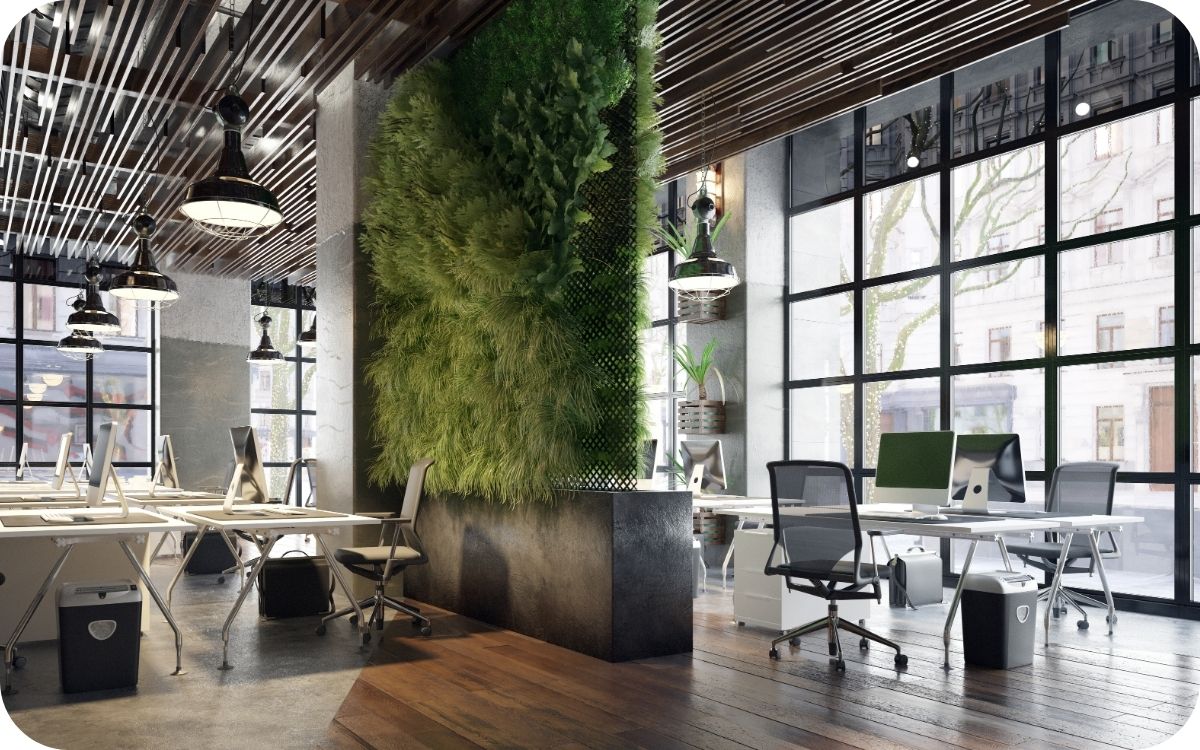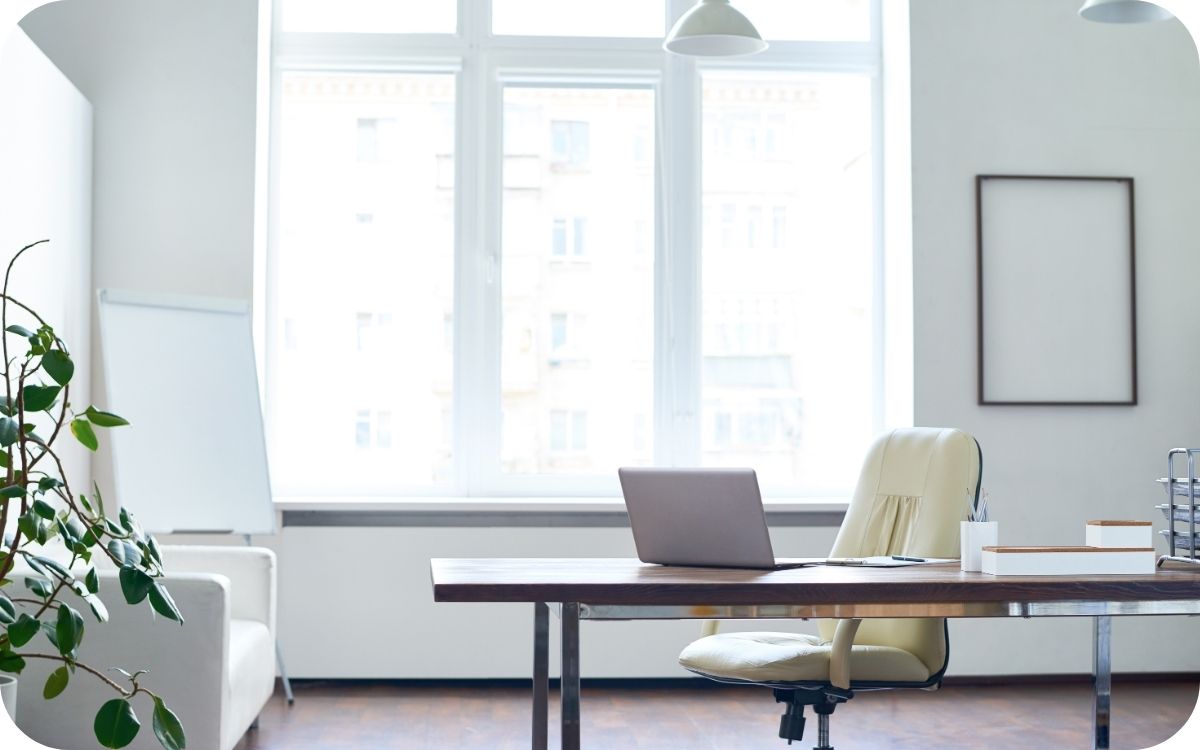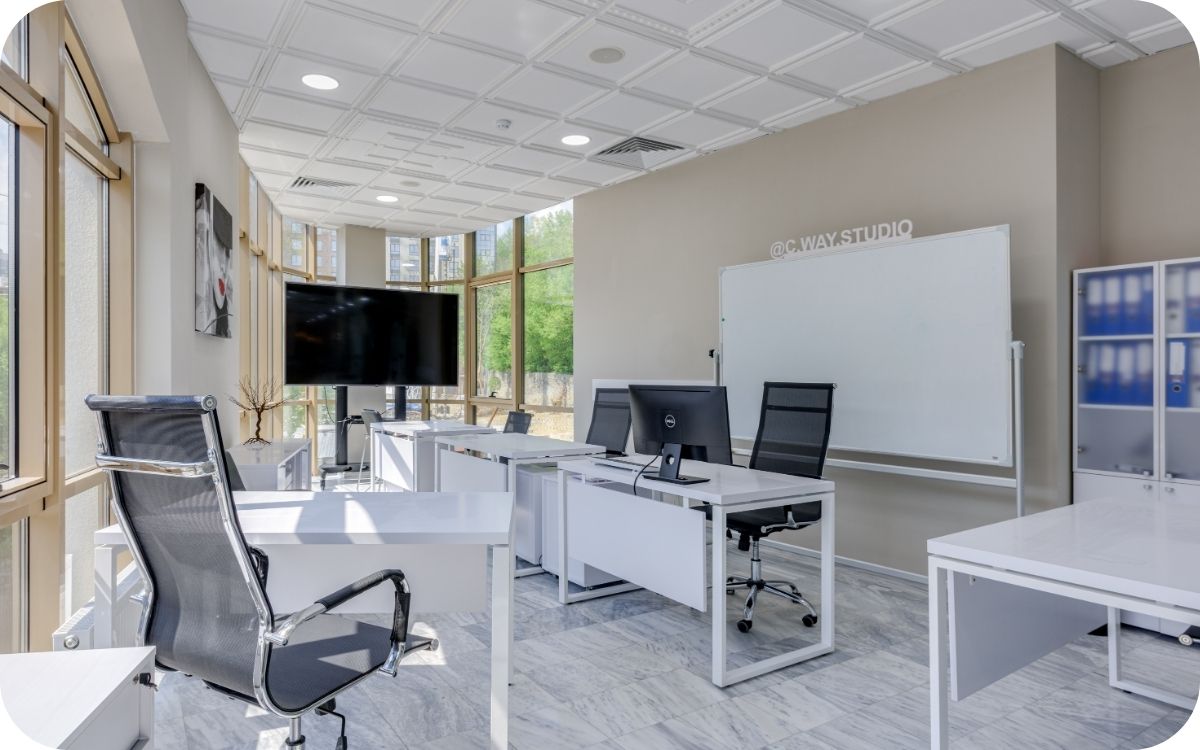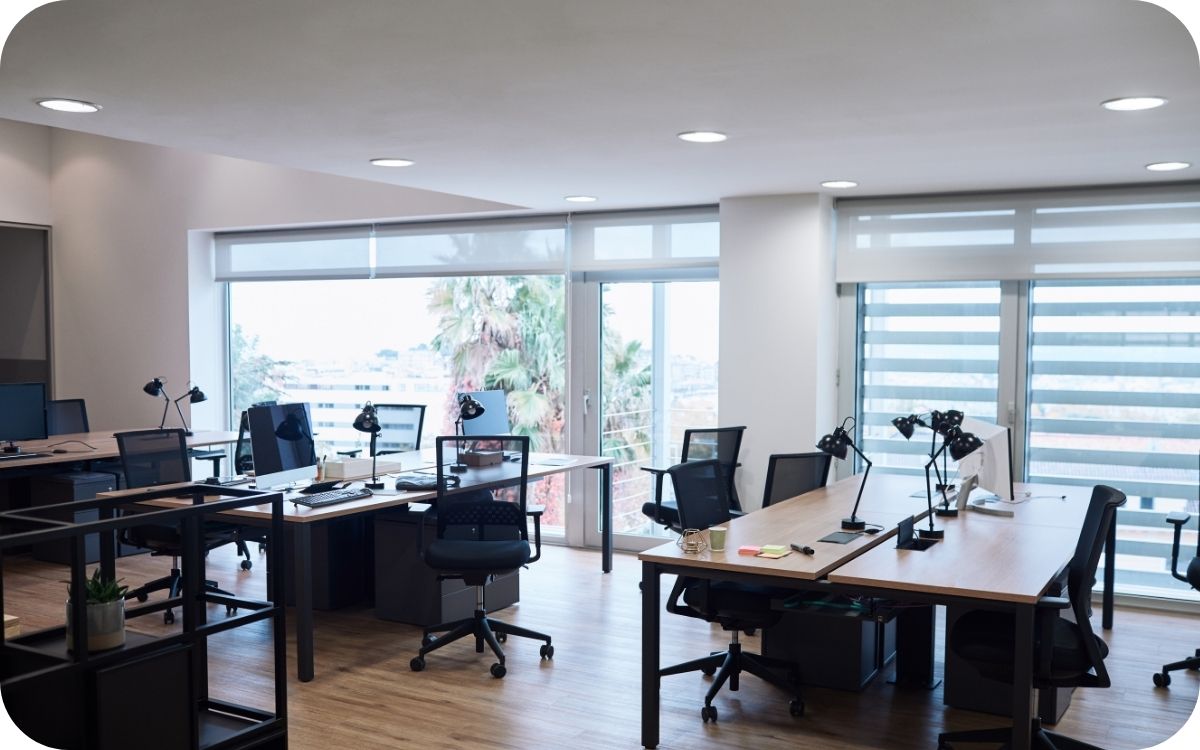Choosing the Best Width Desk For Your Workspace
Desk shopping isn’t just about colour, finish or extra features - get the width wrong and even the smartest workstation can feel cramped or overwhelm the room. With home working now a part of everyday life for many, measuring up has become as important as logging in. An office desk that fits your space and working style will boost comfort, productivity and the overall look of the room.
In this guide, we’ll walk you through the most popular desk widths - from ultra-compact 80cm models for tight corners to expansive 180cm surfaces that can handle multi-monitor rigs and printers. You’ll learn how to measure accurately, match widths to different tasks, and avoid common pitfalls like blocked drawers or tangled cables. By the end, you’ll know exactly which size desk will help you work smarter - not just harder.

Why Desk Width Matters
Choosing the right width for your desk is more than just a matter of fitting it into a room. It directly affects how comfortable and efficient your working environment will be.
Productivity and Comfort
A desk that’s too narrow can lead to clutter, limited movement, and poor posture, especially if you're juggling a monitor, keyboard, documents, and a cup of tea all in one tight spot. On the other hand, a well-sized desk gives you the space to work freely, organise your essentials, and maintain better ergonomics throughout the day.
Impact on Room Flow and Storage
Your desk isn’t just a standalone item. It interacts with everything around it. A desk that's too wide for the room can block drawers, doorways, or create awkward walkways, particularly in shared spaces or multi-use rooms. The right width allows for enough clearance to move comfortably, use under-desk storage, or slide in a pedestal cabinet.
Resale and Longevity Considerations
Picking a desk size that’s too niche or too large can limit its long-term usefulness. A well-proportioned desk, neither too small nor too dominating, has a better chance of fitting into future rooms if you move house or repurpose your workspace. It can also be easier to resell or reuse elsewhere in the home.
Desk Widths at a Glance
At ChairOffice, we offer desks in a range of standard widths to suit every kind of space and working style. Whether you're working from a compact bedroom or setting up a full-scale office, there's a desk size that fits just right.
Here’s a quick overview of our most popular widths and what they’re best suited for:
|
Width |
Best for |
|
80 cm (800 mm) |
Ideal for very small spaces, student rooms, or minimalist laptop setups. |
|
100 cm (1000 mm) |
A compact choice that still allows room for a monitor, keyboard, and notepad. |
|
120 cm (1200 mm) |
A balanced option for most home offices, offering enough room for dual screens and paperwork. |
|
140 cm (1400 mm) |
Perfect for those needing extra workspace for creative tasks, gaming, or larger peripherals. |
|
160 cm (1600 mm) |
Suited to busier workstations in professional or shared spaces. |
|
180 cm (1800 mm) |
Our widest standard option, ideal for multi-monitor setups, printers, and team use. |
These widths increase in 20 cm steps, making it easy to move up or down depending on your room size and work demands. Understanding these options is a great starting point before you begin measuring.
Measuring Your Space
Before choosing a desk, it’s essential to measure your space properly. Getting accurate measurements helps you avoid common pitfalls like blocked doorways, tight walkways, or not having enough room for your office chair to slide back comfortably.

Footprint vs Usable Surface Area
Start by measuring the total space where you plan to place your desk, including any skirting boards, radiators, or other fixed features. Remember that a desk’s width is measured from side to side, but don’t forget to factor in the desk depth too (front to back), especially if the room is narrow.
Allowing Clearance for Chairs, Drawers and Doors
As a general rule, leave at least 60 cm behind your chair so you can move freely. If your desk will sit near a door, window, or built-in wardrobe, make sure there’s enough clearance for everything to open without hitting the desk or chair. Also consider space for under-desk storage or pedestals.
Depth and Cable-Routing Tips
Most desks are between 60 cm and 80 cm deep. If you’re placing your desk against a wall, think about plug socket locations and cable access. Leaving a small gap behind the desk or using desks with built-in cable ports can help you keep things neat and accessible.
Taking a few minutes to plan your layout now will save time, hassle, and potential returns later.
Matching Width to Your Working Style
Your ideal desk width depends not just on room size, but how you plan to use it day-to-day. Whether you’re a casual user or a full-time home worker, your working habits should guide your choice.

Minimalist or Laptop-Only Use (80 cm – 100 cm)
If you mainly use a laptop or just need a small space to sit and work occasionally, an 80 cm or 100 cm desk is a smart, space-saving choice. These compact widths are perfect for student rooms, hallway corners, or tight bedroom spaces where every centimetre counts.
Standard Home Office Setup (120 cm)
The 120 cm width is a popular all-rounder, offering enough space for a monitor and keyboard with room left for notebooks, a lamp or a cup of tea. It’s a great middle ground for remote workers who want function without the desk dominating the room.
Creative, Gaming or Dual-Monitor Use (140 cm – 160 cm)
Designers, gamers, and those working with multiple screens often need more space to breathe. A 140 cm or 160 cm desk gives you the extra surface area to spread out your gear, whether it’s sketchpads, drawing tablets or a full gaming setup.
Multi-User, Printers or CAD Layouts (180 cm+)
A 180 cm desk is the go-to option for serious multitaskers. These wider desks are ideal for those who run a printer, use specialist equipment like CAD tools, or want to share the desk space with another person. They’re also well-suited to commercial office environments or shared workstations.
Room-by-Room Advice
Not every workspace is the same, and the right desk width often depends on the type of room you're working with. Here’s how to choose a size that fits both your space and your setup.
Box Rooms and Student Halls
In small bedrooms or student accommodation, space is at a premium. An 80 cm or 100 cm desk is usually the best fit, offering just enough room for studying or laptop use without making the space feel cramped. Look for models with built-in storage to maximise functionality.
Bedroom or Guest-Room Hybrids
If your desk will share space with a bed or needs to double as a dressing table, aim for something compact but functional. A 100 cm or 120 cm desk gives you space to work without encroaching on the rest of the room. Choose a style that blends in with your décor to keep things feeling calm and uncluttered.
Dedicated Home Office
With a room dedicated to work, you have more freedom. A 120 cm to 160 cm desk is a great range to consider, depending on how much equipment you use. If you’re running multiple monitors or doing paperwork-heavy tasks, don’t be afraid to go wider for maximum comfort and efficiency.
Open-Plan or Shared Commercial Spaces
In professional or shared environments, desk widths of 140 cm to 180 cm are often the norm. These offer enough surface area for files, monitors, phones, and collaboration tools. Consider how your desk will sit alongside others and whether there’s space for chairs to move freely between workstations.
Ergonomics and Cable Management
Choosing the right desk width isn’t just about fitting your space - it also plays a big role in your comfort and how tidy your setup feels day to day.

Optimal Reach Zone and Monitor Distance
A wider desk allows you to keep essential items within easy reach while maintaining good posture. Ideally, your monitor should sit about an arm’s length away from your eyes. On narrower desks, you may feel cramped or find yourself sitting too close to the screen. Wider desks help you maintain better ergonomic positioning.
Under-Desk Storage and Legroom
Make sure your chosen desk width leaves enough space underneath for your legs and any storage you plan to use, like a pedestal or filing cabinet. With very narrow desks, you might sacrifice legroom if you try to squeeze in extra drawers. Wider desks often give you more flexibility to add under-desk units without making things feel tight.
Keeping Cables Tidy
Cable management becomes more important the more equipment you have. Wider desks make it easier to route cables neatly behind your setup and avoid tangled leads. Look for desks with integrated cable ports or pair your desk with cable trays and clips to keep everything organised and off the floor. A clean workspace not only looks better but makes it easier to focus.
Planning for the Future
A desk is an investment, and choosing the right width now can save you the hassle of replacing it later. Thinking ahead ensures your workspace can adapt to your changing needs.
Allowing for Equipment Upgrades
You might only need a laptop today, but what if you add a second monitor, printer, or docking station down the line? Choosing a slightly wider desk now—say 120 cm instead of 100 cm—can give you the flexibility to expand your setup without starting from scratch.
Modular Add-Ons and Return Desks
Some desks are designed to grow with you. Modular options, like return desks or attachable side tables, let you extend your workspace as your needs evolve. If you think you’ll need more surface area in future, consider a core desk that supports add-ons without looking mismatched.
Moving House or Office
A desk that fits your current room might not suit your next one. Medium-width desks, like 120 cm or 140 cm models, tend to be the most versatile if you're planning to move or reconfigure your setup. They strike a good balance between space-saving and usability, and they’re easier to reposition than oversized models.
Frequently Asked Questions
Here are some of the most common questions we hear from customers when it comes to desk widths:
Is a 120 cm desk big enough for dual monitors?
Yes, most 120 cm desks can comfortably fit two standard-sized monitors side by side, along with space for a keyboard and mouse. If you prefer extra room for documents or accessories, consider a 140 cm or 160 cm option.
What is the most popular desk width?
120 cm is one of the most popular choices, especially for home offices. It offers a good balance of surface space and room fit without being too bulky.
Can I use a 100 cm desk for working from home full-time?
You can, especially if you use a laptop or a compact monitor setup. However, if you're working long hours or need space for more equipment, you may find 120 cm or more more comfortable in the long run.
How much space should I leave around my desk?
Ideally, leave at least 60 cm behind your desk for your chair to move freely, and a few centimetres on either side to prevent it from feeling cramped against walls or furniture.
Is it better to get a bigger desk than I need?
Not always. A desk that’s too wide for your space can disrupt room flow or make it harder to fit other furniture. It’s best to measure carefully and choose a width that meets your needs without overwhelming the room.
Are wider desks always deeper too?
Not necessarily. Many desks maintain a standard depth (often 60–80 cm) regardless of width. Always check the full dimensions to ensure it suits your space.
Conclusion & Next Steps
Choosing the right width for your desk is one of the most important decisions you’ll make when setting up a workspace. It affects how comfortable you feel, how productive you are, and how well your desk fits into the room.
Start by measuring your available space carefully, then think about how you work and what equipment you use. Whether you’re after a compact 80 cm desk for occasional laptop use or a spacious 180 cm setup for a dual-monitor workstation, there’s a perfect size for every setup.
Ready to find your fit? Explore our full range of desks by width:
Each collection is designed to make it easy for you to choose a desk that matches your space and working style.






